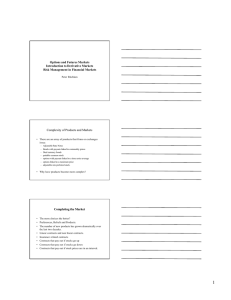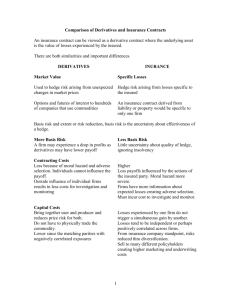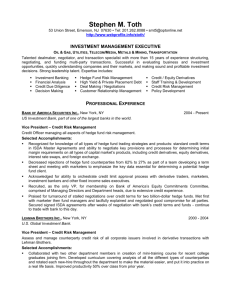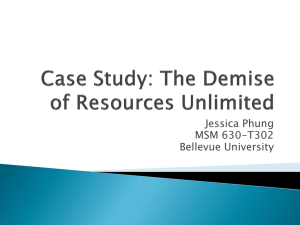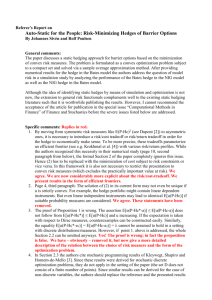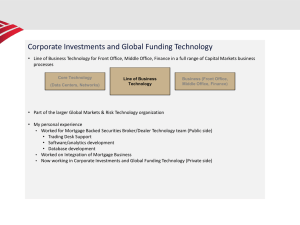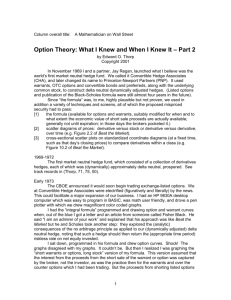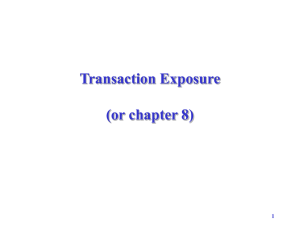Summary of Interview Questions
advertisement
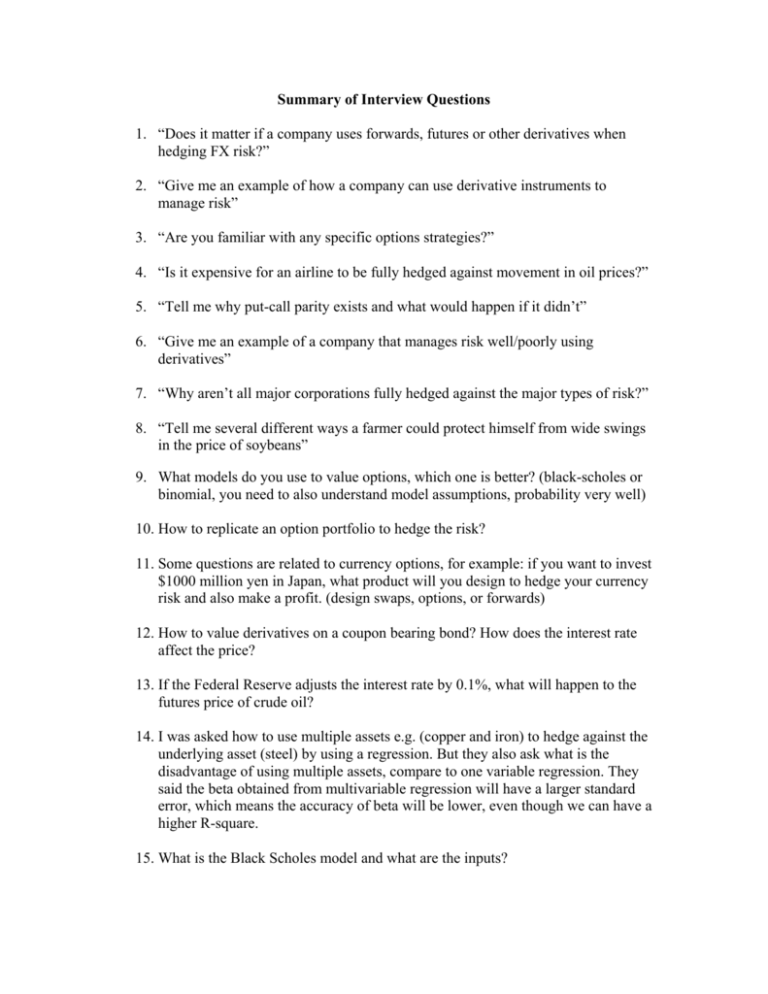
Summary of Interview Questions 1. “Does it matter if a company uses forwards, futures or other derivatives when hedging FX risk?” 2. “Give me an example of how a company can use derivative instruments to manage risk” 3. “Are you familiar with any specific options strategies?” 4. “Is it expensive for an airline to be fully hedged against movement in oil prices?” 5. “Tell me why put-call parity exists and what would happen if it didn’t” 6. “Give me an example of a company that manages risk well/poorly using derivatives” 7. “Why aren’t all major corporations fully hedged against the major types of risk?” 8. “Tell me several different ways a farmer could protect himself from wide swings in the price of soybeans” 9. What models do you use to value options, which one is better? (black-scholes or binomial, you need to also understand model assumptions, probability very well) 10. How to replicate an option portfolio to hedge the risk? 11. Some questions are related to currency options, for example: if you want to invest $1000 million yen in Japan, what product will you design to hedge your currency risk and also make a profit. (design swaps, options, or forwards) 12. How to value derivatives on a coupon bearing bond? How does the interest rate affect the price? 13. If the Federal Reserve adjusts the interest rate by 0.1%, what will happen to the futures price of crude oil? 14. I was asked how to use multiple assets e.g. (copper and iron) to hedge against the underlying asset (steel) by using a regression. But they also ask what is the disadvantage of using multiple assets, compare to one variable regression. They said the beta obtained from multivariable regression will have a larger standard error, which means the accuracy of beta will be lower, even though we can have a higher R-square. 15. What is the Black Scholes model and what are the inputs? 16. Why doesn't the Black-Scholes model work for valuing warrants? (Ans: Warrants are rights on NEW equity. BS does not account for flotation costs or dilution effect.) 17. What are 5 things that affect an options price using the Black Scholes model? 18. I got asked to derive the Black Scholes model and how it relates to the binomial model. 19. I also was asked to price options on rolls of 8 sided dice. They asked both single and multiple roll pricing. 20. "What is an option?" 21. "How would someone make money from a call/put option?" 22. "If you had $50,000, how would you invest it" (diversification, etc.) 23. How do you value an option? 24. The recent devaluation of the dollar affected a lot of companies recently. What can they do? 25. What are the things that affect options prices? 26. What is a swap? 27. What is interest rate risk? 28. How do Pension funds/insurance companies manage risk? What are the risks that they normally face? 29. One Treasurer asked me what determines the price of some commodity in the future. 30. Another guy asked me how the value of China's currency will change? 31. "Q: Say I have a bag full of 100 marbles. I pull out a random number of marbles, which can vary equally from 0-100. If you can guess the number of marbles within 10 either way, I will give you a dollar for each marble that I pull out of the bag (e.g., if you guess 30 and I pull out 40, you get $40). Otherwise, you receive nothing. What is the most amount of money you would pay to play this game?" "A: The guess that you make and the amount that you are willing to pay are independent of one another. Because the number can vary equally from 0-100, you are always best off to guess 90, as that captures the highest possible range of 80-100 marbles. If you guess 90, you will win 20% of the time. Within the range, $90 will be your average winning. 20% of 90 = $18, which is the expected value of playing this game with optimal strategy. $18 is the absolute most you would be willing to pay for this game." 32. You have a client interested in purchasing a 1 week call option (time to maturity = 1 week) on a stock currently trading at $100 with a strike price of $100. You, as the trader, determine that the option premium is $3 / contract. This is a special option where the option represents 1000 shares of the underlying stock. Questions are as follows: a. b. c. d. e. f. g. Draw the risk profile for a call option at expiration Calculate the premium received from the sale of the option. (Ans = $3000) You are now short 1 call option. What can you do to eliminate this exposure? (Ans = you cannot use Put-Call Parity to create a synthetic call as there are no 1 week put options available; therefore, you need to do a delta hedge) How do you do such a delta hedge in this case? (Ans = borrow B money to buy D stock) What is the initial value of B and D, i.e. what is the hedge ratio? (Ans = start with h = 0.5) You leave for the day and come back tomorrow (day 2) and the stock price has risen to $102. What do you do? (Ans = borrow more money to buy more stock) How much more stock do you buy, i.e. what is your new hedge ratio h? This goes on (i.e. the stock price goes from $100 to $102 to $98 to....) each day of the week until the call expires. I needed to adjust my delta hedge position every day and calculate the cost of changing my position (no commissions and risk free rate = 0%). At the end of the exercise, I was required to calculate the net profit on the entire position from the initial $3000 premium to all of the costs associated with adjusting my delta hedge every day. The net profit was on the order of $2700. I was then required to explain why I still made money when I was buying stock at high prices (i.e. $102) and selling stock at low prices (i.e. $98). I gave the answer that we actually lost money during all of those delta hedging transactions since we started with $3000 and ended up with only $2700. So, we lost $300 on all those transactions where we bought high and sold low. However, the goal of the transactions is to hedge out your exposure to any price risk in the stock....that was accomplished and we paid $300 to accomplish that...leaving us with $2700 net profit from completing the deal. He then went one step farther and asked how this type of exercise can be used to prove that option premiums increase with increasing stock volatility. I said that as the volatility rises, then you will lose more money on each delta hedge transaction (i.e. you will be buying higher and selling lower than the above example). This will make you demand a higher option premium so that your net profit is still the same...approximately. Anyway, this example took the whole 30 minute interview to complete. Not fun, but I thought I did well....thanks to your class. 33. The question was who benefits from callable bonds, the company or the investor, and therefore who needs to pay a premium on the “option”? The second, which I initiated: what if it’s a callable, convertible bond? In this case, the holder has the “option” to convert, and the company has the “option” to call in the bond, so the actual price of the bond (in addition to the value of the asset itself) would depend on the value of the company’s option vs. the value of the holder’s option. 34. Couple derivative and risk management questions I have encountered (partly because I had a credit derivatives trading background over the past summer) relate to hedging with CDS contracts and how they function, and the VaR concept (what does it mean, how do they affect the strategy of the business). The basic concepts of entering into a derivatives contract, such as what the payments are, what the payments are contingent upon, and the value of the contract. For instance, theoretically, since YTM = treasury + libor spread + credit spread, they asked me specific questions regarding to the value of the credit, etc. Hope this helps. 35. How much would an option be worth with a two dollar strike price? The payoffs equal the number faced up on a 6sided die after it is rolled. 36. Why and when should a company issue a convertible bond? 37. How do you value a convert? 38. Why doesn’t the Black Scholes model apply to valuing warrants? 39. What are the inputs of the BS model? 40. I interviewed with Goldman Sachs in Private Wealth Management and one of the questions was: ”I have some London-based clients who complained about the returns of the assets that were invested in the U.S. because of the weak dollar. What could you have done?” [Answer: hedging with futures for example]. 41. Last year in a consulting interview I was told that one of the problems facing a CPG client (similar to Kraft) was an unexpected increase in the price of raw materials, specifically milk and sugar. Among the options available to the company, I identified the use of substitutes, vertical integration into suppliers and use of options or futures to lock in the price of milk and sugar. 42. I did a number of investment banking interviews, so my derivative and risk management questions were minimal, but there definitely were some. I was consistently asked the five variables in the Black-Scholes equation and how I would go about getting them. As a follow up, there were often questions similar to your homework, asking what happened if volatility or some other variable increased/decreased. I also was asked about portfolio theory and what betas mean, including negative betas. 43. What happens when delta is negative and gamma is positive? (Lehman) What is theta? When is it most useful?(SAC) In general it is not only important to know the definitions of the greeks, but also their signs(+/-) and when it is important to hedge using them. 44. What can we do about FX risk - FX hedges such as future and options. 45. I was asked about real options as part of the valuation of some projects in Brazil.
